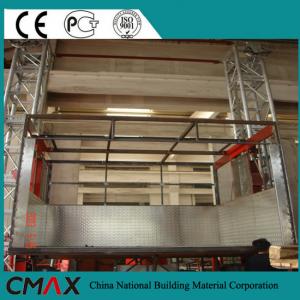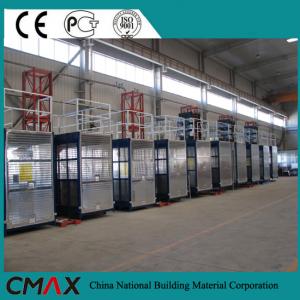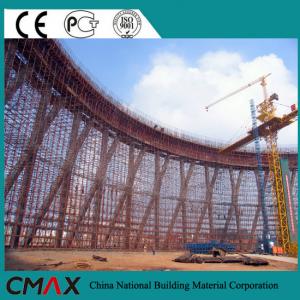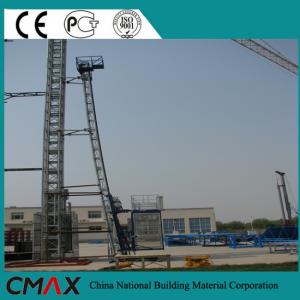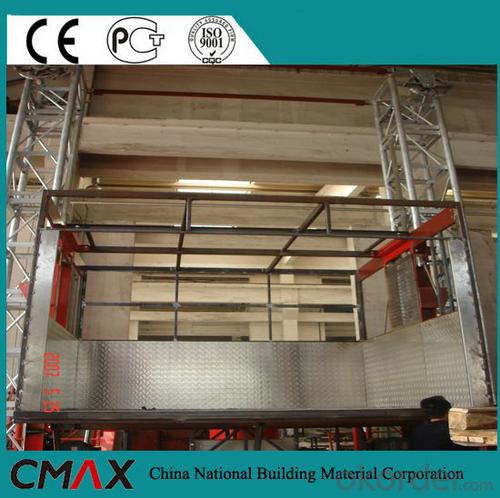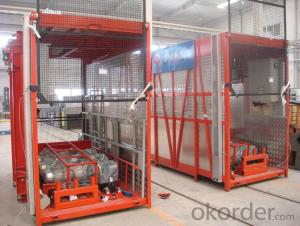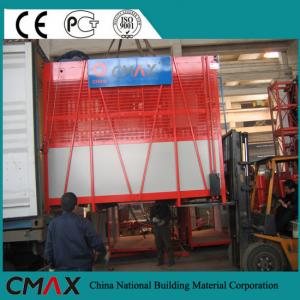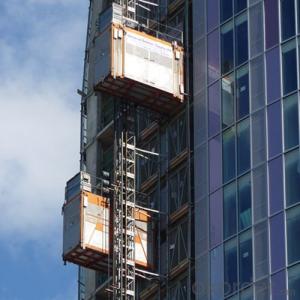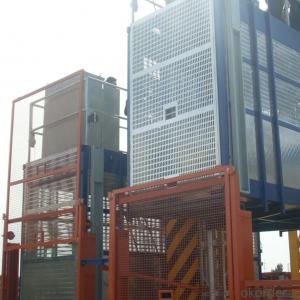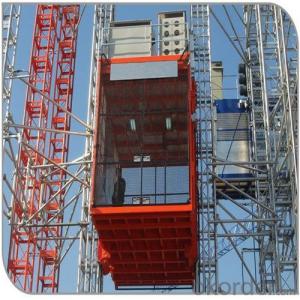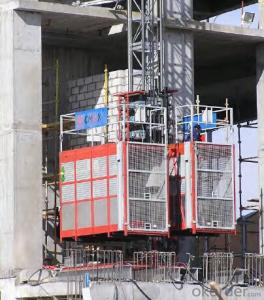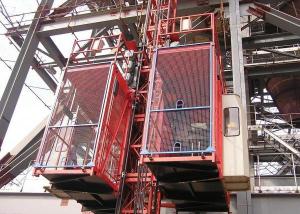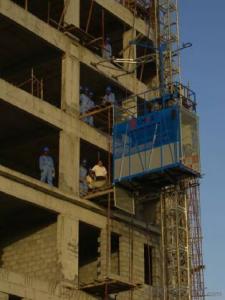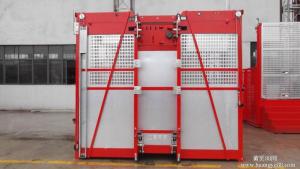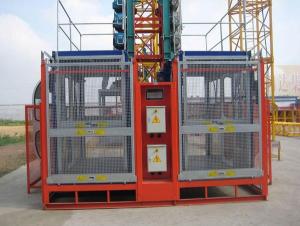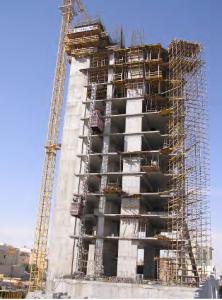Building Hoist (Model:SC(D)120, SC(D)120/120) with high Qulity
- Loading Port:
- China main port
- Payment Terms:
- TT or LC
- Min Order Qty:
- 1 pc
- Supply Capability:
- 20 pc/month
OKorder Service Pledge
OKorder Financial Service
You Might Also Like
Structure of Construction Hoist Description
(1)Creativeintroduce design philosophy single reducer dual output, the successful trial of a recyclable waste rack unit modular dual output construction lifts, lift the rack and pinion contact stress decreased by 50%, the transmission of the modular units can maximize the elimination of the error superimposed gear pair in the rack height direction, so that the whole movement is very smooth, greatly improving the rack and pinion and other key pieces of the life of this technological innovation for three national patents.
(2)A kind of automatic leveling floor, overload protection control and floor call, the three-in-one smart console application. Construction hoist intelligent automatic leveling floor, to ensure that the hoist can accurately place, to reduce machine wear and impact, and also slow down the drivers frequent operation of the degree of fatigue.
(3)Integrated operating room, frequency control system integration cabin. To strengthen safety and real using of hoist cage top job, at the same time greatly improve the aesthetic effect of the engine, the technology won the national patent.
(4)Advanced frequency control system. The construction elevator VVVF frequency control electrical control system adopts the most advanced frequency control and microcomputer programmable logic controller (PLC) control. Frequency control technology make the motor start, the braking process variable speed, ease the mechanical impact, and increased running stability, extended machine life. Brake can be achieved a zero speed, thereby extending the life of the brake. Frequency control system with a current limiting function, leaving the motor difficulty in starting the motor starting current, reducing the impact on the grid to ease the impact of the site electrical equipment, not because of the long distance power supply cable voltage drop. Frequency control system further comprising: overvoltage, undervoltage, overcorrect, overload, prevent stalling and other security features.
(5)Two Hardened reducerreached transmission efficiency up to 94%, big carrying capacity, long life. Efficient hardened gear together with the the advanced frequency electronic control system to lift the use of more energy-efficient. Construction ladder down the gravitational potential energy and kinetic energy is almost equivalent conversion, so that the motor operating current is almost zero, year-on-year ordinary domestic construction lift a nearly 50% reduction in energy-saving effect.
Construction Hoist Specifiction
Name | Building Hoist |
Model | SC100, SC100/100 |
Certificate | ISO9001:2000 |
Capacity | 1000kg/cage |
Lifting speed | 36m/min,or 0~63m/min,or 0~96m/min |
Mast section: | Paint or hot dipping zinc |
Cage | Single cage or twin cage |
Cage size | (L x W x H) (m): 2.5 x 1.3 x 2.5; 3.0 x 1.3 x 2.5; 3.2 x 1.5 x 2.5; 3.6 x 1.5 x 2.5; 3.8 x 1.5 x 2.5; 4.0 x 1.5 x 2.5; 4.2 x 1.5 x 2.5, cage dimension is according to requirement of customer and special project |
Motor | Top brand of China,also can be SEW motor. |
Reducing device | Top brand of China |
Counterweight | With or without counterweight |
The colors of cage | yellow, or red, or blue |
Images of construction hoist
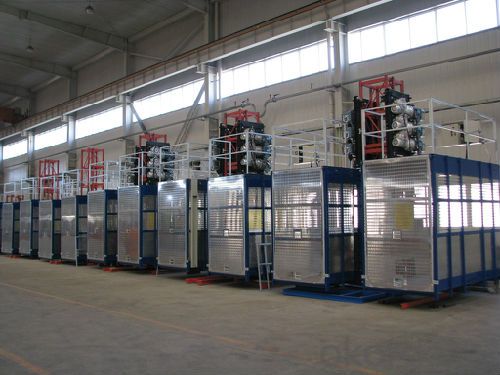

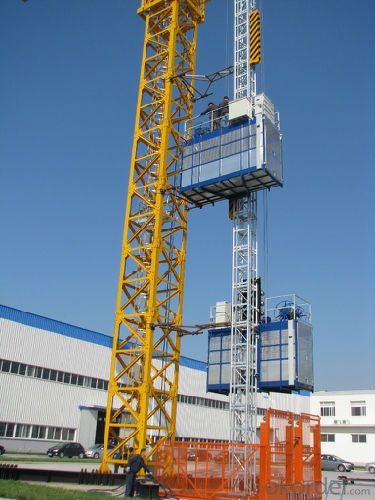
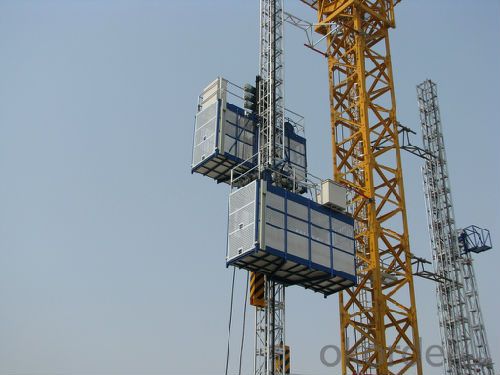
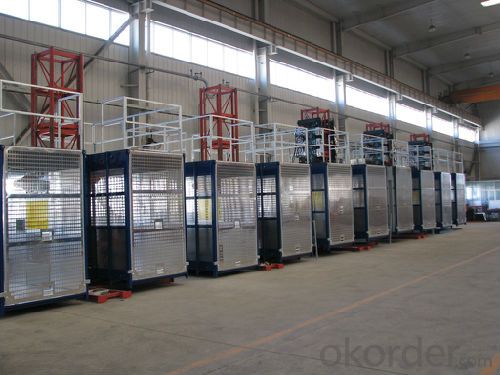
FAQ of Construction Hoist
Q: What is the building hoist main purpose?
A: Building hoist equipped with double or single cabin to transport the materials and labors up and down. It's the ideal
construction equipment for vertical transportation in the field of construction.
Q: What is the main structure of building hoist?
A: The P/M construction hoist mainly contains metal structure, driving system, electrical control system, cable guide & protection system, electrical top crane and safety device.
- Q: This question asks for a list of various types of lifting equipment commonly used in the construction industry.
- <p>In construction, various types of lifting equipment are utilized to move heavy materials and structures. These include cranes such as tower cranes, mobile cranes, and crawler cranes, which are versatile and can lift heavy loads to significant heights. Forklifts are used for lifting and moving materials over short distances. Telescopic handlers, also known as cherry pickers, provide both lifting and access capabilities. Hoists are used for lifting smaller loads and are often found in workshops or on construction sites. Derricks are fixed structures used for lifting heavy loads in a specific area. Lifting slings and shackles are used in conjunction with cranes and hoists to secure loads. Finally, aerial work platforms, like scissor lifts and boom lifts, provide elevated access for workers and materials. Each type of lifting equipment serves a specific purpose and is chosen based on the nature of the construction project and the weight and size of the loads to be moved.</p>
- Q: This question asks for the steps or methods to change the height at which a building hoist operates.
- <p>To adjust the height of a building hoist, follow these steps: Ensure the hoist is powered off and unplugged. Locate the height adjustment mechanism, which is typically a set of bolts or a telescoping system. Loosen any locking nuts or bolts to allow movement. Adjust the hoist height by raising or lowering the platform to the desired level. Once the correct height is reached, tighten the nuts or bolts to secure the hoist in place. Test the hoist to ensure it operates safely at the new height. Always refer to the manufacturer's instructions for specific details on your hoist model.</p>
- Q: Explain the distinctions between electric and hydraulic power sources used in building hoists.
- <p>Electric hoists use electric motors to generate power, which is more environmentally friendly and requires less maintenance. They are often quieter, easier to control, and can be more energy-efficient. Hydraulic hoists, on the other hand, rely on fluid pressure to generate power. They can provide greater lifting capacity and are often used in heavy-duty applications. Hydraulic systems can be more complex to maintain and repair, and they may not be as energy-efficient as electric hoists. However, they offer smooth and controlled lifting, which is beneficial in certain construction scenarios.</p>
- Q: This question asks for the method to determine the maximum weight that a building hoist can safely lift.
- <p>To calculate the lifting capacity of a building hoist, you need to consider several factors. First, identify the hoist's rated capacity, which is usually specified by the manufacturer. This is the maximum weight the hoist is designed to lift. Next, assess the condition of the hoist, including any wear and tear that might affect its performance. Check the hoist's mechanical components, such as cables, pulleys, and motors, to ensure they are in good working order. Additionally, consider the weight of the load you intend to lift and any additional factors like the frequency of lifts or the height of the lift. Always operate within the hoist's rated capacity and follow safety guidelines to prevent accidents.</p>
- Q: This question asks for a comparison between electric and pneumatic building hoists, highlighting their distinct features and operational differences.
- <p>Electric building hoists are powered by electricity and are known for their high lifting capacity, speed, and efficiency. They are suitable for heavy-duty applications and can be automated for continuous operation. Pneumatic hoists, on the other hand, use compressed air to generate lifting force. They are quieter, require less maintenance, and are safer in environments where electrical sparks could be hazardous. However, they have lower lifting capacities and are generally slower compared to electric hoists. Pneumatic hoists are also more suitable for applications requiring precise control over the load.</p>
- Q: This question asks about the steps or measures to ensure the safe installation of a building hoist, which is a device used in construction for lifting materials and personnel.
- <p>To install a building hoist safely, follow these steps: 1. Ensure the site is clear and secure, with proper access and no obstructions. 2. Check that the hoist is suitable for the load and building structure. 3. Assemble the hoist according to the manufacturer's instructions. 4. Install the hoist on a stable and level base, ensuring it is securely anchored to the building. 5. Conduct a thorough inspection of all components for any defects or damage. 6. Test the hoist with a trial run to ensure all functions work correctly. 7. Train operators on the safe use and operation of the hoist. 8. Obtain any necessary permits and inspections from local authorities. 9. Regularly inspect and maintain the hoist to ensure ongoing safety.</p>
- Q: The user is asking if it's possible to use a building hoist, typically used for construction, to lift a car.
- <p>Using a building hoist to lift a car is not recommended. Building hoists are designed for lifting materials and equipment in construction settings, not for vehicles. They may not have the appropriate safety features or load-bearing capacity for a car. Attempting to lift a car with a building hoist could result in damage to the car, the hoist, or even personal injury. For lifting a car, it's best to use a vehicle-specific lift or a hydraulic lift designed for such purposes, ensuring safety and proper support.</p>
- Q: What are the specific safety mechanisms and controls that are typically incorporated into the design of a building hoist to ensure its safe operation?
- <p>Building hoists, also known as construction hoists, are equipped with several safety devices and controls to ensure safe operation. These include limit switches to prevent overtravel, safety locks that engage if the hoist sways excessively, emergency stop buttons for immediate cessation of movement, overload protection to prevent the hoist from lifting more than its capacity, and interlock systems that ensure the hoist cannot operate if a safety gate is open. Additionally, there are guardrails, toe boards, and anti-fall devices to protect workers from falling. Regular inspections and maintenance are also crucial for the safe operation of building hoists.</p>
- Q: Explain the key differences between electric and hydraulic lifting equipment, including their power sources, efficiency, and applications.
- <p>Electric lifting equipment is powered by electric motors and typically operates through cables or batteries, making them quieter and more environmentally friendly. They are often used in indoor settings where noise and emissions are a concern. Hydraulic lifting equipment, on the other hand, uses hydraulic fluid and pistons to generate force, providing high power and torque. They are commonly used in heavy-duty applications and outdoors. Electric systems are generally more energy-efficient and have lower maintenance costs, while hydraulic systems offer greater power density and can handle heavier loads.</p>
- Q: Elevator installation approach, need to give the total package (inspect) what data, come a master to answer the detail point
- Elevator random documents, material verification documents, product certificate.
Send your message to us
Building Hoist (Model:SC(D)120, SC(D)120/120) with high Qulity
- Loading Port:
- China main port
- Payment Terms:
- TT or LC
- Min Order Qty:
- 1 pc
- Supply Capability:
- 20 pc/month
OKorder Service Pledge
OKorder Financial Service
Similar products
Hot products
Hot Searches
Related keywords
